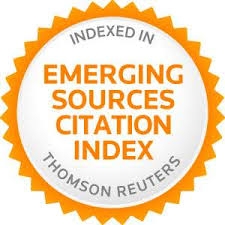Qué sabe el alumnado de secundaria sobre la Unión Europea? Implicaciones para el aprendizaje
Resumen
Palabras clave
Referencias
Agidarg, O., Huyst, P. & Van Houte, M. (2012). Determinants of the formation of a European identity among children: individual and school level influence. Journal of Common Market Studies, 50, 198-213. doi: http://doi.org/10.1111/j.1468-5965.2011.02205.x
Amadeo, J., Torney-Purta, J., Lehmann, R., Husfeldt, V. & Nikolova, R. (2002). Civic knowledge and engagement among upper secondary pupils in sixteen countries. Amsterdam: IEA.
Bombardelli, O. & Santana, L.E. (2014). European citizens are groving up. Madrid: EOS.
Bovero, M. (2002). Una gramática de la democracia: contra el gobierno de los peores. Madrid: Trotta.
Committee on Culture and Education of European Parliament (2016). On Learning EU at school (2015/2138(INI), Retrieved from http://www.europarl.europa.eu/sides/getDoc.do?pubRef=-//EP//TEXT+REPORT+A8-2016-0021+0+DOC+XML+V0//EN
Council of the European Union (2014). Council Regulation (EU) No 390/2014 of 14 April 2014 establishing the ‘Europe for Citizens’ programme for the period 2014-2020. Official Journal of the European Union, 17/4/14. 1.115/3
del Río, S. (2009). Reactivar la ciudadanía europea comunicando Europa. Pliegos de Yuste. Revista de Cultura, Ciencia y Pensamiento Europeo, 9-10, 67-76.
EACEA (2012). Citizenship education at schools in Europe. Brussels: EACEA.
EACEA (2013). Youth participation in democratic life. Brussels: EACEA.
EACEA (2016). Promoting citizenship and the common values of freedom, tolerance and non-discrimination through education. Brussels: EACEA.
Ebel, R.L., & Frisbie, D.A. (1986). Essentials of education measurement. Englewood Cliffs, NJ: Prentice Hall.
European Commission (2011). European Commission proposes to make 2013 “The European Year of Citizens”. Retrieved from http://europa.eu/rapid/press-release_IP-11-959_en.htm
European Commission (2012). European citizenship. Standard Eurobarometer 77. Brussels: European Commission.
European Commission (2013). European Union Citizenship Flash Eurobarometer 365. Brussels: European Commission.
European Commission (2014). European Citizenship Standard Eurobarometer 81. Brussels: European Commission.
European Commission (2015). ANNEX to the Commission implementing decision on the adoption of the 2016 work programme and the financing for the implementation of the Europe for Citizens programme. Brussels: European Commission.
EURYDICE (2005). La Educación para la ciudadanía en el contexto escolar europeo, Bruselas: EURYDICE.
Fischman, G & Haas, E. (2012). Beyond idealized citizenship education: Embodied cognition, metaphors, and democracy. Review of Research in Education, 36, 169-196. doi: http://doi.org/10.3102/0091732X11420927
Georgi, V.B. (2008). Citizens in the Making: Youth and Citizenship Education in Europe. Child Development Perspectives, 2, 107-113. doi: http://doi.org/10.1111/j.1750-8606.2008.00050.x
Greppi, A. (2012). La democracia y su contrario. Representación, separación de poderes y opinión pública. Madrid: Trotta.
Halász, G. & Michel, A. (2011). Key competences in Europe: interpretation, policy formulation and implementation. European Journal of Education, 46, 289-306. doi: http://doi.org/10.1111/j.1465-3435.2011.01491.x
Hernández Rodríguez, E. (2008). Acercar Europa a los europeos: un reto vital. Madrid: Euroeditions, Books for Europe’s future.
Horvath, A. & Paolini, G. (2013). Political participation and EU citizenship: Perceptions and behaviours of young people. Brussels: EACEA.
Huyst, P. (2009). The Europeans of tomorrow: Researching European identity among young Europeans. Gent University, Centre for EU Studies.
Jamieson, L. (Coord.) (2007). Orientations of young men and women to citizenship and European identity. Brussels: European Commission. Directorate General for Research Citizen and Governance in a knowledge-based society.
Kerr, D., Sturman, L., Schulz, W. & Burge, B. (2010). ICCS 2009 European Report. Civic knowledge, attitudes and engagement among lower secondary pupils in 24 European countries. Amsterdam: International Association for the Evaluation of Educational Achievement.
Kuhn, T. (2016). The social stratification of European schoolchildren’s transnational experiences: A cross-country analysis of the International Civics and Citizenship Study. European Sociological Review, 32(2), 266-279. doi: http://doi.org/10.1093/esr/jcv097
Mahendran, K. & Cook, D. (2007). Young people’s views on participation and their attitudes towards the European Union: building a bridge between Europe and its citizens. Edinburg: Scottish Executive Social Research.
Marshall, H. (2009). Educating the European citizen in the global age: engaging with the post-national and identifying a research agenda. Journal of Curriculum Studies, 41, 247-267. doi: http://doi.org/10.1080/00220270802642002
Milana, M. (2008). Is the European (active) citizenship ideal fostering inclusion within the Union? A critical review. European Journal of Education, 43, 207216. doi: http://doi.org/10.1111/j.1465-3435.2008.00344.x
Myers, J.P. & Zaman, H.A. (2009). Negotiating the global and national: Immigrant and dominant culture adolescents’ vocabularies of citizenship in a transnational world. Teachers College Record, 111(11), 2589-2625.
Morales, P. (2012). Análisis de ítems en las pruebas objetivas. Madrid: Universidad Pontificia Comillas, Facultad de Ciencias Humanas y Sociales.
Naval, C., Print, M. & Veldhuis, R. (2002). Education for democratic citizenship in the new Europe: Context and reform. European Journal of Education, 37, 107-128. doi: http://doi.org/10.1111/1467-3435
Sloam, J. (2013). Voice and equality. Young people's politics in the European Union. West European Politics, 36, 1-23. doi: http://doi.org/10.1080/01402382.2012.749652
Torney-Purta, J. (2002). Patterns in the civic knowledge. Engagement. and attitudes of European adolescents: The IEA Civic Education Study. European Journal of Education, 37, 129-141. doi: http://doi.org/10.1111/1467-3435.00098
Torney-Purta, J., Cabrera, J., Crotts, K., Liu, O.L. & Rios, J. (2015). Assessing Civic Competency and Engagement in Higher Education: Research Background, Frameworks, and Directions for Next-Generation Assessment. ETS Research Report Series, 2, 1-48. doi: http://doi.org/10.1002/ets2.12081
Tsafos, N. (2006). Growing up a European. SAIS Review of International Affairs, 26, p. 181. . doi: https://doi.org/10.1353/sais.2006.0046
UNESCO (2015). Global Citizenship Education. Topics and learning objectives. Paris: United Nations Educational, Scientific and Cultural Organization.
Verhaegen, S., Hooghe, M. y Meeusen, C. (2016). Opportunities to learn about Europe at school. A comparative analysis among European adolescents in 21 European member states. Journal of Curriculum Studies, 45(6), 838-864. doi: http://doi.org/10.1080/00220272.2013.800995
Enlaces refback
- No hay ningún enlace refback.


